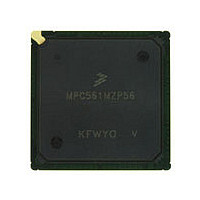MPC561MZP56 Freescale, MPC561MZP56 Datasheet - Page 256

MPC561MZP56
Manufacturer Part Number
MPC561MZP56
Description
Manufacturer
Freescale
Datasheet
1.MPC561MZP56.pdf
(1420 pages)
Specifications of MPC561MZP56
Cpu Family
MPC56x
Device Core
PowerPC
Device Core Size
32b
Frequency (max)
56MHz
Interface Type
QSPI/SCI/SPI/UART
Total Internal Ram Size
32KB
# I/os (max)
56
Number Of Timers - General Purpose
22
Operating Supply Voltage (typ)
2.6/5V
Operating Supply Voltage (max)
2.7/5.25V
Operating Supply Voltage (min)
2.5/4.75V
On-chip Adc
2(32-chx10-bit)
Instruction Set Architecture
RISC
Operating Temp Range
-40C to 125C
Operating Temperature Classification
Automotive
Mounting
Surface Mount
Pin Count
388
Package Type
BGA
Program Memory Type
ROMLess
Program Memory Size
Not Required
Lead Free Status / RoHS Status
Not Compliant
Available stocks
Company
Part Number
Manufacturer
Quantity
Price
Company:
Part Number:
MPC561MZP56
Manufacturer:
Freescale Semiconductor
Quantity:
10 000
Company:
Part Number:
MPC561MZP56R2
Manufacturer:
Freescale Semiconductor
Quantity:
10 000
- Current page: 256 of 1420
- Download datasheet (11Mb)
System Configuration and Protection
6.1.4.5
The interrupt overhead consists of two main parts:
The interrupt overhead can increase latency, and decrease the overall system performance. The overhead
of register saving time can be reduced by improving the operating system. The number of registers that
should be saved can be reduced if each interrupt event has its own interrupt vector. This solution solves
the interrupt source recognition overhead.
Only registers required for the recognition routine are considered to be saved in the calculations below.
Recognition of module internal events/channels is out of the scope of the calculations. See also the typical
interrupt handler flowchart in
6-16
•
•
Operation
Storage of general and special purpose registers
Recognition of the interrupt source
Details
Notes:
Total:
Interrupt Overhead Estimation for Enhanced Interrupt Controller Mode
Compiler and bus collision overhead are not included in the calculations.
If there is a need to enable
At Least 70-80 Clocks
Interrupt propagation from
request module to RCPU —
Store of some GPR and
SPR—10 clocks
Read SIPEND—4 clocks
Read SIMASK—4 clocks
SIPEND data processing —
20 clocks
(find first set, access to LUT in
the Flash, branches)
Read UIPEND—4 clocks
UIPEND data processing—20
clocks
(find first set, access to LUT in
the Flash, branches)
nesting of interrupts during
source recognition procedure,
at least 30 clocks should be
added to the interrupt latency
estimation
Architecture Without Using
8 clocks
Table 6-5. Interrupt Latency Estimation for Three Typical Cases
MPC561/MPC563
SIVEC
Figure
MPC561/MPC563 Reference Manual, Rev. 1.2
6-6.
Table 6-5
Interrupt propagation from
request module to RCPU —
Store of some GPR and SPR
—10 clocks
Read SIVEC—4 clocks
Branch to routine—10 clocks
Read UIPEND—4 clocks
UIPEND data processing —
(find first set, access to LUT in
the Flash, branches)
To use this feature in compressed
mode some undetermined
latency is added to make a
branch to compressed address of
the routine. This latency is
dependant on how the user code
is implemented.
At Least 50-60 Clocks
MPC561/MPC563 Architecture
8 clocks
20 clocks
NOTE
below illustrates the improvements.
Using SIVEC
Interrupt propagation from
request module to RCPU —
Store of some GPR and
SPR—10 clocks
Only one branch is executed to
reach the interrupt handler
routine of the device requesting
interrupt servicing—2 clocks
—
20 Clocks
6 clocks
Enhanced Interrupt
Controller Features
Architecture Using
MPC561/MPC563
Freescale Semiconductor
Related parts for MPC561MZP56
Image
Part Number
Description
Manufacturer
Datasheet
Request
R

Part Number:
Description:
MPC5 1K0 5%
Manufacturer:
TE Connectivity
Datasheet:

Part Number:
Description:
MPC5 500R 5%
Manufacturer:
TE Connectivity
Datasheet:

Part Number:
Description:
MPC5 5K0 5%
Manufacturer:
Tyco Electronics
Datasheet:

Part Number:
Description:
MPC5 5R0 5%
Manufacturer:
Tyco Electronics
Datasheet:

Part Number:
Description:
MPC5 50K 5%
Manufacturer:
Tyco Electronics
Datasheet:

Part Number:
Description:
MPC5 1R0 5%
Manufacturer:
Tyco Electronics
Datasheet:

Part Number:
Description:
TOWER ELEVATOR BOARDS HARDWARE
Manufacturer:
Freescale Semiconductor
Datasheet:

Part Number:
Description:
TOWER SERIAL I/O HARDWARE
Manufacturer:
Freescale Semiconductor
Datasheet:

Part Number:
Description:
LCD MODULE FOR TWR SYSTEM
Manufacturer:
Freescale Semiconductor
Datasheet:

Part Number:
Description:
DAUGHTER LCD WVGA I.MX51
Manufacturer:
Freescale Semiconductor
Datasheet:

Part Number:
Description:
TOWER SYSTEM BOARD MPC5125
Manufacturer:
Freescale Semiconductor
Datasheet:












